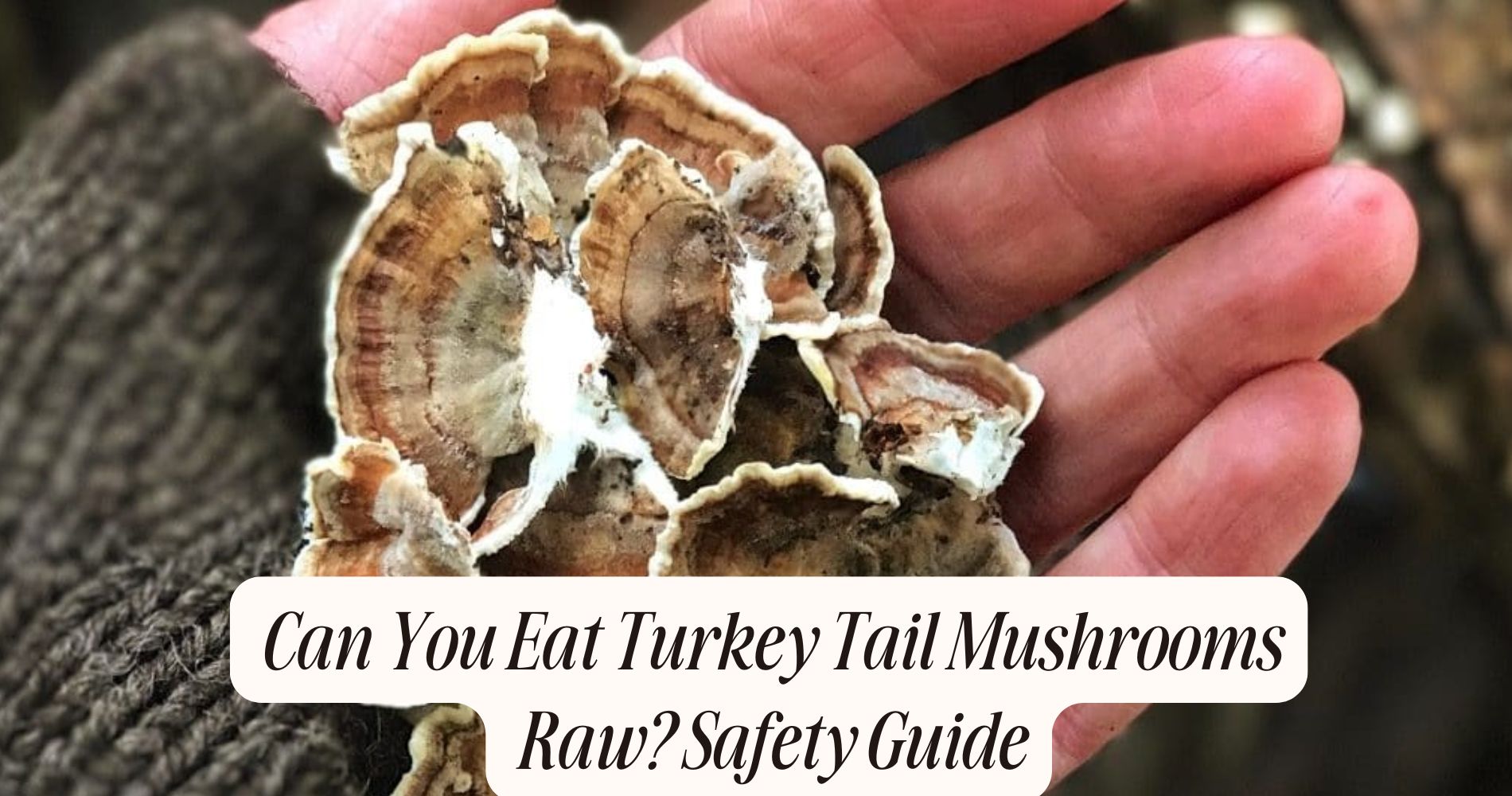
Can You Eat Turkey Tail Mushrooms Raw? Safety Guide
Can you eat turkey tail mushrooms raw? You shouldn't eat turkey tail mushrooms raw due to potential health risks. Raw consumption can lead to nausea, vomiting, or diarrhea, as these mushrooms have a tough structure that complicates digestion. Cooking them not only improves safety but also enhances flavor and nutrient absorption. Methods like sautéing, steeping in hot water for tea, or adding them to soups are recommended. For proper enjoyment and health benefits, stick to a typical serving size of 1 to 2 grams. There's more to discover about identifying edible turkey tail and safe preparation methods that can elevate your culinary experience.
Nutritional Benefits of Turkey Tail Mushrooms
When you consider incorporating Turkey Tail mushrooms into your diet, you'll discover they offer impressive nutritional benefits. These mushrooms are packed with polysaccharides, particularly beta-glucans, which provide robust immune support. By enhancing your immune system's response, Turkey Tail can help your body ward off illnesses more effectively.
Additionally, Turkey Tail mushrooms boast significant antioxidant properties. Antioxidants are essential for combating oxidative stress, which can lead to cellular damage and various chronic diseases. By including these mushrooms in your meals, you're not only nourishing your body but also fighting free radicals that contribute to aging and health issues.

You can enjoy Turkey Tail in various forms, such as teas, powders, or capsules, making it easy to integrate into your daily routine.
Whether you're looking for a natural supplement or a flavorful addition to your dishes, Turkey Tail mushrooms provide a versatile option.
Safety Concerns of Raw Consumption
When you consider eating raw turkey tail mushrooms, it's important to be aware of potential safety concerns.
They can pose toxicity risks, cause digestive issues, and hinder your body's ability to absorb their nutrients effectively.
Understanding these factors can help you make informed choices about how to enjoy these mushrooms safely.
Toxicity Risks
Turkey tail mushrooms, while celebrated for their health benefits, pose potential toxicity risks when consumed raw. Although these fungi are generally regarded as safe when cooked or processed, eating them in their raw state can lead to adverse effects.
It's crucial to recognize the signs of toxicity symptoms, which may include nausea, vomiting, diarrhea, or even allergic reactions. Mushroom safety should always be your priority, especially when experimenting with new varieties.
The raw consumption of turkey tail mushrooms mightn't trigger immediate reactions for everyone, but individual sensitivities vary greatly. Some people might experience gastrointestinal discomfort, while others could develop more severe issues.
You should also consider potential contamination during foraging or storage, as this can introduce harmful pathogens. Cooking turkey tail mushrooms not only enhances their flavor but also greatly reduces any risk of toxicity.
If you're unsure about the safety of raw consumption, it's best to err on the side of caution and incorporate them into your meals after proper cooking. Always consult with a healthcare professional if you have concerns about mushroom safety or experience any toxicity symptoms after consumption.
Digestive Issues
Raw consumption of turkey tail mushrooms can lead to various digestive issues, making it essential to understand the potential risks. While these mushrooms are packed with beneficial compounds, your digestive system might struggle to process them raw.
Turkey tail mushrooms contain tough, fibrous cell walls that can be hard for your body to break down without the aid of cooking. This can hinder the effectiveness of your digestive enzymes, which are vital for breaking down food and absorbing nutrients.
If you consume turkey tail mushrooms in their raw state, you might experience bloating, gas, or even nausea. These digestive disturbances can disrupt your gut health, leaving you feeling uncomfortable.
Cooking the mushrooms not only softens their texture but also enhances their digestibility, allowing your body to utilize their benefits more effectively.
To enjoy turkey tail mushrooms while minimizing digestive issues, consider preparing them in soups, teas, or as a supplement. This way, you can reap the health benefits without risking your gut health.
Always prioritize your digestive comfort when adding new foods to your diet, especially those that are tough to digest.
Nutritional Absorption
Consuming turkey tail mushrooms in their raw form can hinder your body's ability to absorb their valuable nutrients effectively. The primary issue lies in the nutrient bioavailability of these mushrooms. When consumed raw, the tough cell walls can block your body from accessing essential compounds, reducing absorption efficiency.
Turkey tail mushrooms are packed with polysaccharides, antioxidants, and other beneficial compounds, but these nutrients become more available when cooked. Cooking breaks down the tough structure of the mushrooms, making it easier for your digestive system to extract and utilize the nutrients.

If you decide to consume them raw, you might miss out on the full spectrum of health benefits they offer. The nutrients may not be absorbed effectively, leading to a waste of potential health-enhancing properties.
For ideal nutrient absorption, consider cooking turkey tail mushrooms or preparing them in teas or extracts. This way, you guarantee that your body can access and benefit from the rich array of nutrients they provide.
Always prioritize methods that enhance nutrient bioavailability to maximize your health outcomes.
Potential Toxins in Turkey Tail
When foraging for mushrooms like turkey tail, it's crucial to be aware of potential toxins that could pose health risks. While turkey tail (Trametes versicolor) is generally considered safe, its chemical composition can vary among mushroom varieties, leading to unexpected reactions in some individuals.
Turkey tail mushrooms themselves don't contain the dangerous toxins found in some other wild mushrooms, like the infamous Amanita species. However, if you're foraging, you must guarantee you're accurately identifying the turkey tail and not confusing it with toxic look-alikes. Misidentification can lead to serious health issues.
It's also worth noting that, while turkey tail is rich in beneficial compounds, excessive consumption may lead to digestive discomfort for some. Remember, your body may react differently based on your individual tolerance to specific compounds found in mushrooms.
If you're unsure about your identification skills or the effects on your body, it's best to consult with an expert or avoid consuming them raw altogether.
Prioritize your safety by being informed and cautious during your foraging adventures.
Cooking Methods for Turkey Tail
Turkey tail mushrooms can be prepared in several delicious and nutritious ways that highlight their unique flavor and health benefits. One popular method is sautéing. You can use sautéing techniques to bring out the earthy flavor of the mushrooms.
Simply slice the turkey tail into smaller pieces, heat some oil in a pan, and sauté them until they're tender. This method not only enhances their taste but also makes them a great addition to stir-fries or as a topping for various dishes.
If you want to preserve turkey tail mushrooms for later use, consider drying methods. You can air-dry them by hanging them in a warm, dry place, or use a food dehydrator for quicker results.

Once dried, you can easily rehydrate them in soups or stews, adding a rich, umami flavor.
Another option is to steep dried turkey tail in hot water to create a nourishing tea. This method captures the beneficial compounds while providing a warm, comforting drink.
Whichever method you choose, turkey tail mushrooms can be a fantastic and healthful addition to your meals.
Recommended Serving Sizes
When it comes to turkey tail mushrooms, knowing the right serving size is essential for reaping their benefits safely.
Generally, daily recommendations suggest around one to two grams, but you should consider your own health needs and any other supplements you're taking.
Let's break down what portion sizes work best for you.
Daily Serving Recommendations
For those looking to incorporate turkey tail mushrooms into their diet, it's generally recommended to start with a daily serving of 1 to 3 grams of dried extract. This amount allows you to enjoy the potential health benefits without overwhelming your system.
Gradually increasing your daily intake can help you assess how your body responds to the mushrooms.
You might want to contemplate your serving frequency as well. Taking turkey tail mushrooms consistently—whether daily or a few times a week—can maximize their benefits.
Some people prefer to split their daily dose into two servings, taking 1 to 1.5 grams in the morning and again in the evening. This can help maintain stable levels of beneficial compounds in your system throughout the day.
Always listen to your body. If you experience any adverse reactions, it's best to reduce your intake or consult a healthcare professional.
Portion Size Considerations
Considering the varying needs and preferences of individuals, recommended serving sizes for turkey tail mushrooms can differ based on factors like age, health status, and overall diet.
For most adults, a typical serving size ranges from 1 to 2 grams of dried turkey tail mushrooms. If you're contemplating raw consumption, you might want to start with a smaller portion, such as a few grams, to see how your body reacts.
Portion management is essential, especially if you're new to consuming these mushrooms. Remember, everyone's digestive system is unique. If you experience any discomfort, it's best to reduce your intake or consult a healthcare professional.
For those with specific health goals, like boosting immunity or supporting gut health, you might find that a consistent daily intake of turkey tail mushrooms aligns well with your dietary needs.
However, always listen to your body and adjust accordingly.
If you're incorporating turkey tail into your diet, consider it as part of a balanced meal. This approach not only enhances flavor but also guarantees you're getting a variety of nutrients.
Stay mindful of your portion sizes to make the most of the health benefits without overdoing it.
How to Identify Edible Varieties
Identifying edible turkey tail mushrooms involves paying close attention to their distinct characteristics. First, look for the fan-shaped caps that can measure up to 4 inches wide, typically featuring concentric zones of varying colors, ranging from brown to orange. These vibrant bands are key identification techniques to distinguish them from inedible varieties.
Next, observe the underside of the mushroom. Edible turkey tails have a smooth, pale white to cream-colored surface with tiny pores, not gills. You'll also want to check for a firm, leathery texture, which is another essential mushroom characteristic.

When foraging, choose specimens that grow on decaying wood, as this habitat indicates they're likely edible. Avoid mushrooms that appear slimy or have a foul odor, as these could be harmful.
Finally, it's always wise to consult a reliable field guide or an experienced forager, especially if you're new to mushroom hunting. Remember, accurate identification is vital; consuming the wrong mushroom can lead to serious health issues.
With these tips, you'll be better equipped to identify and enjoy turkey tail mushrooms safely!
Frequently Asked Questions
Can Turkey Tail Mushrooms Be Consumed in Smoothies or Juices?
You can definitely add turkey tail mushrooms to smoothies or juices. They offer nutritional benefits like antioxidants and immune support. Try incorporating them into your favorite smoothie recipes for a healthy boost to your drinks!
Are There Any Allergic Reactions Associated With Turkey Tail Mushrooms?
You should be aware that some people experience turkey tail allergies or mushroom sensitivities. If you've had reactions to other mushrooms before, it's wise to consult a healthcare professional before trying turkey tail mushrooms.
How Do I Store Turkey Tail Mushrooms Properly?
To store turkey tail mushrooms properly, use the best storage methods like drying techniques. Slice them thinly, then dehydrate at low heat. Once dried, keep them in an airtight container away from light and moisture.
Can I Find Turkey Tail Mushrooms in My Backyard?
You can find turkey tail mushrooms in your backyard if you know how to identify them. Foraging in local woods or on decaying logs increases your chances of discovering these fascinating fungi. Always be cautious!
Do Turkey Tail Mushrooms Interact With Medications?
Turkey tail mushrooms may interact with some medications. While they offer medicinal benefits, it's important to check dosage recommendations and potential side effects. Always consult your healthcare provider before adding turkey tail to your routine.
Conclusion
In summary, while turkey tail mushrooms offer impressive nutritional benefits, it's best to avoid eating them raw due to potential safety concerns and toxins. Cooking these mushrooms not only enhances their flavor but also makes them safer to consume. Always verify you're identifying the edible varieties correctly to enjoy their health benefits. So, get creative with your cooking methods and savor the goodness of turkey tail mushrooms while prioritizing your safety!




